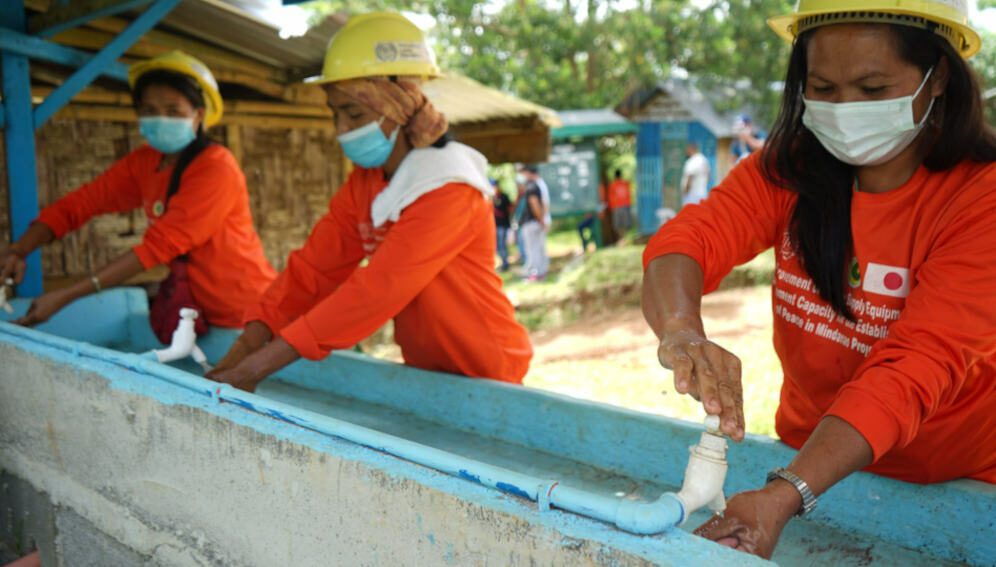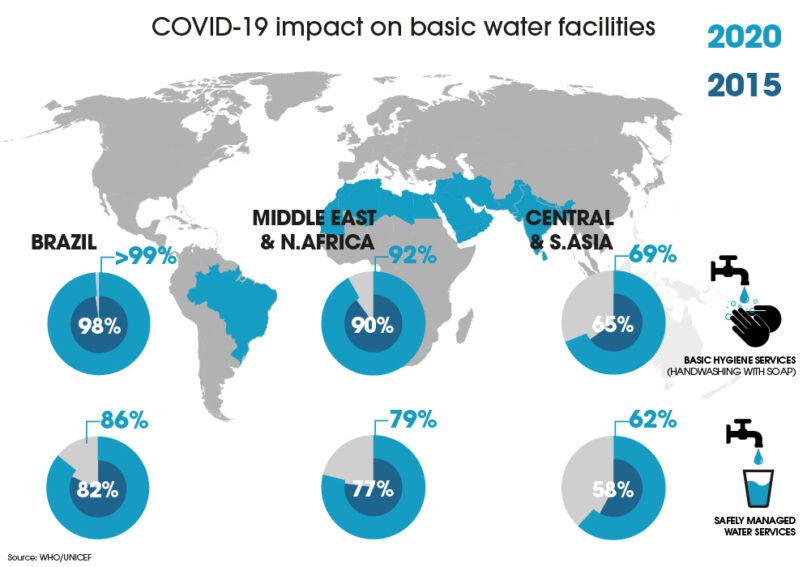29/03/22
Sanitation progress slows to a crawl amid pandemic

By: Fiona Broom
Send to a friend
The details you provide on this page will not be used to send unsolicited email, and will not be sold to a 3rd party. See privacy policy.
Progress towards universal access to handwashing facilities has slowed in communities from Latin America to Sub-Saharan Africa amid the pandemic, data analysis reveals.
Minor sanitation improvements have been seen in some parts of Asia Pacific, but the most vulnerable families living in camps for displaced people and refugees have had to rely on emergency support.
The findings come from a SciDev.Net data analysis of the availability of handwashing facilities in schools, hospitals, camps and homes around the world.
“In the past decade, access to sanitation and drinking water has advanced very timidly in the face of the challenge we have.”
Edison Carlos, executive president, Trata Brazil Institute
“The pandemic has shed light on an historic problem,” Edison Carlos, executive president of the Trata Brazil Institute, a civil society organisation that monitors sanitation and water resources, told SciDev.Net. “In the past decade, access to sanitation and drinking water has advanced very timidly in the face of the challenge we have [in Brazil].”
Analysis shows that there has been some improvement in sanitation access since the beginning of the pandemic – albeit at a slow pace. According to the UN children’s agency UNICEF, 82 per cent of Brazilians had access to safe water sources in 2015, increasing slightly to 86 per cent in 2020.
With the spread of COVID-19, public pressure and the need for quick action prompted water companies in Brazil to cut through red tape and provide emergency access to water in areas where it was restricted, Carlos says.
“The public water companies installed pipe systems and donated tanker trucks to the poorest communities, installed laundries for the street population and negotiated the water billing debt. But these were emergency actions, not structural ones,” he said.
A joint UNICEF and World Health Organization report shows that between 2015 and 2020, the global population with safely managed sanitation services grew from 47 per cent to 54 per cent, and handwashing facilities with soap and water increased from 67 per cent to 71 per cent.
In South Asia, the rate of improvement in basic handwashing practices between 2015 and 2020 was highest in Bangladesh, at 3.33 per cent. This was followed by Pakistan with 3.15 per cent, Nepal with 1.37 per cent and India with 0.10 per cent.
But the global pandemic has brought the benefits of handwashing into stark relief. Simple handwashing with soap and water has been found to be effective at preventing the spread of COVID-19, as well as other pathogens responsible for diarrhoeal diseases and respiratory illnesses, according to Nicolas Osbert, chief of the water, sanitation and hygiene (WASH) programme at UNICEF in India.



“The other benefit with handwashing is that it helps prevent the development of microbial resistance due to reduced use of antibiotics,” he said.
With the escalation of the pandemic, the demand for water for handwashing purposes increased. Yet the data shows that in 2020, three in every ten people worldwide were unable wash their hands properly in their homes.
In the Arab region, more than 74 million people were left at risk due to lack of access to handwashing facilities. And the increase in water consumption has been detrimental for some communities: in Algeria, water consumption increased with the rise in the number of COVID-19 cases, creating a major water deficit.
In Jordan, one of the most water-stressed countries in the region with the highest refugee population, international agencies have focused on developing water facilities. UNICEF said they helped around 1.75 million children and their families gain access to water sanitation facilities during the pandemic.
“Despite this slight improvement, there is still a lot that needs to be done quickly, especially in conflict countries that are facing funding crises and weaknesses in their health systems,” Amgad El Kholy, a medical epidemiologist at the WHO Eastern Mediterranean office, told SciDev.Net.
In Sub-Saharan Africa, access to safe water is still lacking at some health facilities and schools, as well as at the household level. But the true extent of the sanitation problem remains hidden due to persisting data gaps in many countries in the region, according to a 2020 UNICEF report.
“We still do not know the full extent of the COVID-19 impact on WASH in the region because this is an evolving situation,” Samuel Godfrey, a UNICEF advisor for eastern and southern Africa, told SciDev.Net.
More than half of the world’s children who lacked hygiene facilities at their schools in 2019 were in Sub-Saharan Africa, according to the 2020 report. It found that most schools in Sub-Saharan Africa did not use piped water, but relied on other types of “improved sources”, including boreholes or rainwater.
The cost of piped water for rural households in Kenya is about eight times that of an urban household, according to the Kenya Water for Health Organization.
Rachael McDonnell, deputy director general for the International Water Management Institute, agrees that data is crucial for progress on sanitation. “Credible and timely data are essential to the realisation of the Sustainable Development Goals, as they help decision-makers to identify countries, people and sectors that are left behind, and set priorities for increased efforts and investments,” she said.
This piece was produced by SciDev.Net’s Global desk.















